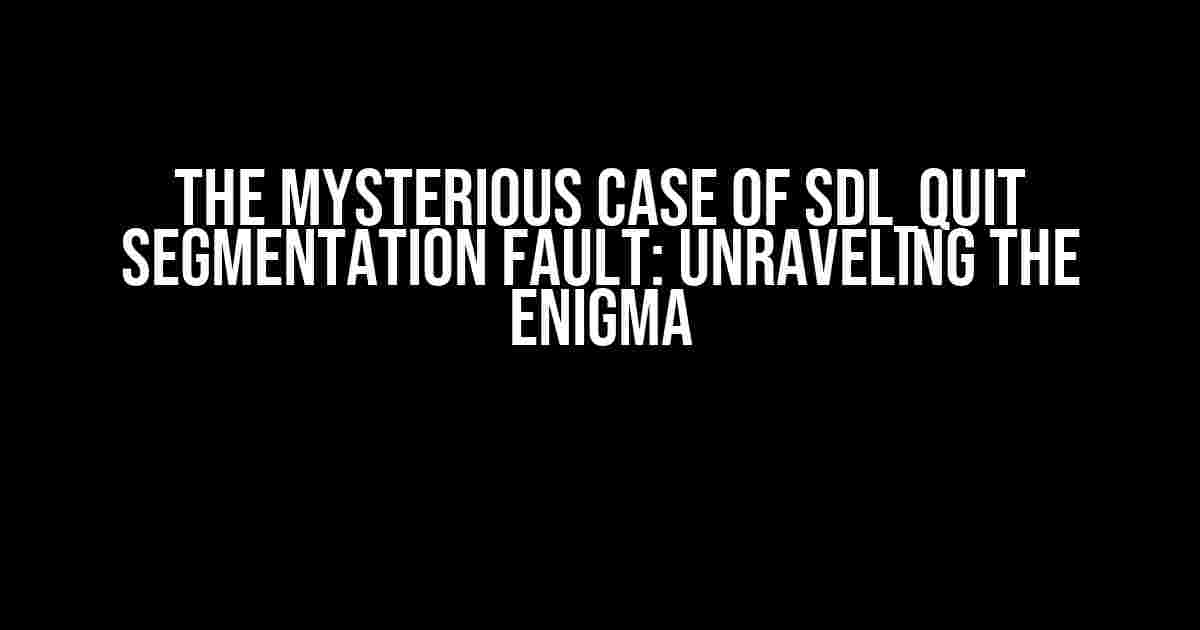Are you tired of encountering the infamous “SDL_Quit segmentation fault” error while developing your game or application using the SDL library? Fear not, dear developer, for we’re about to embark on a thrilling adventure to vanquish this pesky issue once and for all!
What is SDL_Quit Segmentation Fault?
A segmentation fault occurs when a program attempts to access a memory location that it’s not authorized to access or has already been freed. In the context of SDL, the `SDL_Quit` function is responsible for shutting down the SDL subsystems and releasing any allocated resources. However, when things go awry, `SDL_Quit` can trigger a segmentation fault, leaving you bewildered and frustrated.
Common Causes of SDL_Quit Segmentation Fault
Before we dive into the solutions, let’s explore some common culprits behind this error:
- Uninitialized or already freed pointers**: Make sure you’re not passing null or freed pointers to SDL functions, as this can lead to unpredictable behavior and segmentation faults.
- Incorrect SDL initialization**: Verify that you’ve properly initialized SDL using `SDL_Init` and that the initialization was successful.
- Resource leaks**: Ensure you’re releasing all allocated resources, such as surfaces, textures, and audio devices, before calling `SDL_Quit`.
- Thread-related issues**: Be cautious when using multithreading, as SDL is not thread-safe by default. Use SDL’s thread-related functions and locks to ensure thread safety.
- Version incompatibilities**: Ensure you’re using the correct version of SDL and its dependencies, as incompatible versions can lead to unexpected behavior.
Troubleshooting and Solution Strategies
Now that we’ve identified the potential causes, let’s explore some troubleshooting techniques and solution strategies to overcome the `SDL_Quit` segmentation fault:
1. Review Your Code: The Debugger’s Best Friend
Use a debugger to step through your code and pinpoint the exact location where the segmentation fault occurs. This will help you identify the problematic function or line of code.
gdb my_program
(gdb) run
(gdb) backtrace
2. Verify SDL Initialization and Shutdown
Double-check your SDL initialization and shutdown sequences:
if (SDL_Init(SDL_INIT_VIDEO | SDL_INIT_AUDIO) != 0) {
printf("SDL initialization failed: %s\n", SDL_GetError());
return 1;
}
// ... Your SDL code ...
SDL_Quit();
3. Release Resources Before Quitting
Ensure you’re releasing all allocated resources before calling `SDL_Quit`:
// Release surfaces
SDL_FreeSurface(my_surface);
// Release textures
SDL_DestroyTexture(my_texture);
// Release audio devices
Mix_CloseAudio();
SDL_Quit();
4. Handle Threads and Locks with Care
Use SDL’s thread-related functions and locks to ensure thread safety:
SDL_Thread* my_thread = SDL_CreateThread(my_thread_func, "My Thread");
// ... Thread execution ...
SDL_WaitThread(my_thread, NULL);
SDL_LockMutex(my_mutex);
// Critical section of code
SDL_UnlockMutex(my_mutex);
5. Check for Version Incompatibilities
Verify that you’re using compatible versions of SDL and its dependencies:
$ sdl2-config --version
2.0.14
$ pkg-config --modversion sdl2
2.0.14
Real-World Examples and Case Studies
Let’s examine some real-world examples and case studies to better understand how to overcome the `SDL_Quit` segmentation fault:
The Mysterious Case of the Uninitialized Pointer
| Code Snippet | Issue | Fix |
|---|---|---|
SDL_Surface* surface = NULL; |
Passing an uninitialized pointer to SDL functions | SDL_Surface* surface = SDL_CreateRGBSurface(...); |
The Curious Case of the Forgotten Resource Release
| Code Snippet | Issue | Fix |
|---|---|---|
SDL_Texture* texture = SDL_CreateTexture(...); |
Forgetting to release the texture before quitting | SDL_DestroyTexture(texture); |
Conclusion
The `SDL_Quit` segmentation fault can be a frustrating and intimidating error, but by following the troubleshooting techniques and solution strategies outlined in this article, you’ll be well-equipped to tackle and overcome this issue.
Remember to meticulously review your code, verify SDL initialization and shutdown, release resources, handle threads and locks with care, and check for version incompatibilities. By doing so, you’ll ensure a smooth and error-free experience for your users.
Now, go forth and conquer the world of SDL development, and may the segmentation faults be ever in your favor!
Additional Resources
For further reading and exploration:
- SDL documentation: https://wiki.libsdl.org/
- SDL tutorials and guides: https://lazyfoo.net/tutorials/SDL/index.php
- SDL community forums: https://discourse.libsdl.org/
Happy coding, and may your SDL adventures be segmentation fault-free!
Frequently Asked Questions
Got stuck with SDL_Quit segmentation fault? Fear not, dear developer! We’ve got you covered with these FAQs that’ll help you troubleshoot and debug like a pro!
Q1: What is SDL_Quit segmentation fault, and why does it haunt me?
SDL_Quit segmentation fault occurs when there’s an attempt to access memory that’s already been freed or is out of bounds. It’s like trying to find a ghost in the machine – it’s a pesky error that’ll freeze your program. This happens when you call SDL_Quit() without properly releasing resources or when there’s a mismatch between SDL_Init() and SDL_Quit() calls.
Q2: How do I avoid SDL_Quit segmentation fault when using SDL_ttf(rendering text)?
To avoid the segmentation fault when using SDL_ttf, make sure to call TTF_Quit() before SDL_Quit(). This ensures that the font resources are released properly, and you won’t get the segmentation fault.
Q3: Can I use SDL_Quit() multiple times in my program?
No, you shouldn’t call SDL_Quit() multiple times in your program. This can lead to segmentation faults and other unexpected behavior. Instead, call SDL_Init() once at the beginning and SDL_Quit() once at the end of your program.
Q4: How do I debug SDL_Quit segmentation fault in my program?
To debug the segmentation fault, use a debugger like gdb or valgrind to identify the line of code causing the issue. You can also use printf statements or a logging mechanism to track the execution flow and find the point where the error occurs.
Q5: Is there a way to handle SDL_Quit segmentation fault exceptions globally in my program?
Yes, you can use signal handlers to catch segmentation faults globally in your program. However, be cautious when using signal handlers, as they can mask other errors or make your program unstable. It’s better to identify and fix the root cause of the segmentation fault instead of relying on global exception handling.
